Identification of the differentiation-associated Na+/PI transporter as a novel vesicular glutamate transporter expressed in a distinct set of glutamatergic synapses
- PMID: 11756497
- PMCID: PMC6757588
- DOI: 10.1523/JNEUROSCI.22-01-00142.2002
Identification of the differentiation-associated Na+/PI transporter as a novel vesicular glutamate transporter expressed in a distinct set of glutamatergic synapses
Abstract
Glutamate transport into synaptic vesicles is a prerequisite for its regulated neurosecretion. Here we functionally identify a second isoform of the vesicular glutamate transporter (VGLUT2) that was previously identified as a plasma membrane Na+-dependent inorganic phosphate transporter (differentiation-associated Na+/P(I) transporter). Studies using intracellular vesicles from transiently transfected PC12 cells indicate that uptake by VGLUT2 is highly selective for glutamate, is H+ dependent, and requires Cl- ion. Both the vesicular membrane potential (Deltapsi) and the proton gradient (DeltapH) are important driving forces for vesicular glutamate accumulation under physiological Cl- concentrations. Using an antibody specific for VGLUT2, we also find that this protein is enriched on synaptic vesicles and selective for a distinct class of glutamatergic nerve terminals. The pathway-specific, complementary expression of two different vesicular glutamate transporters suggests functional diversity in the regulation of vesicular release at excitatory synapses. Together, the two isoforms may account for the uptake of glutamate by synaptic vesicles from all central glutamatergic neurons.
Figures
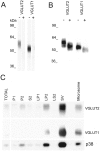

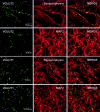
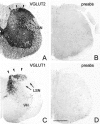


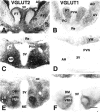

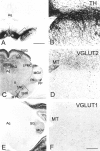

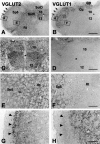

References
-
- Aicher SA, Milner TA, Pickel VM, Reis DJ. Anatomical substrates for baroreflex sympatho-inhibition in the rat. Brain Res Bull. 2000;51:107–110. - PubMed
-
- Aihara Y, Mashima H, Onda H, Hisano S, Kasuya H, Hori T, Yamada S, Tomura H, Yamada Y, Inoue I, Kojima I, Takeda J. Molecular cloning of a novel brain-type Na(+)-dependent inorganic phosphate cotransporter. J Neurochem. 2000;74:2622–2625. - PubMed
-
- al-Awqati Q. Chloride channels of intracellular organelles. Curr Opin Cell Biol. 1995;7:504–508. - PubMed
-
- Bellocchio EE, Reimer RJ, Fremeau RT, Jr, Edwards RH. Uptake of glutamate into synaptic vesicles by an inorganic phosphate transporter. Science. 2000;289:957–960. - PubMed
Publication types
MeSH terms
Substances
Grants and funding
LinkOut - more resources
Full Text Sources
Other Literature Sources
Research Materials
Miscellaneous
